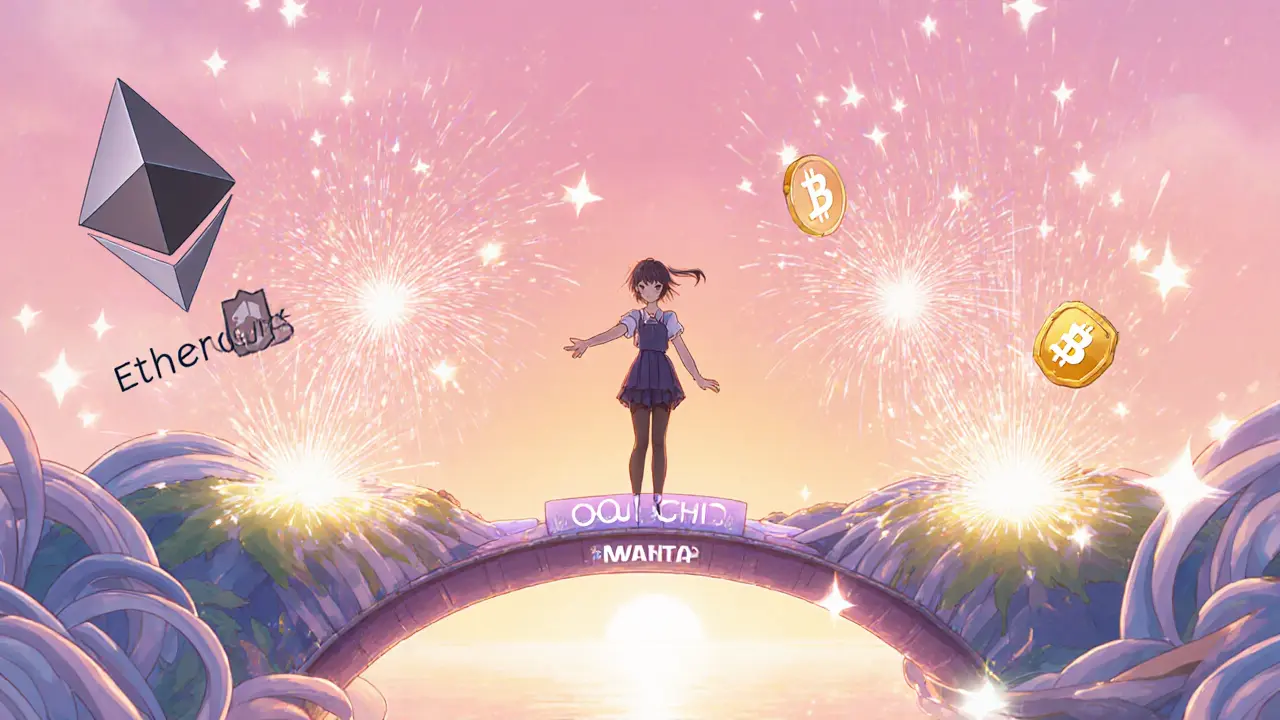QuickSwap V3 (Manta) Review: Zero‑Fee DEX on Manta Network
 Oct, 7 2025
Oct, 7 2025
QuickSwap V3 (Manta) Fee Comparison Calculator
Fee Comparison Overview
QuickSwap V3 (Manta) stands out with a flat 0.00% fee for both makers and takers, unlike other DEXs which charge variable or fixed fees.
| Exchange | Base Fee | Dynamic Fee Model |
|---|---|---|
| QuickSwap V3 (Manta) | 0.00% | No |
| QuickSwap V2 (Polygon) | 0.30% | No |
| QuickSwap V3 (Polygon) | Variable (0.05%–0.30%) | Yes |
| Uniswap V2 | 0.30% | No |
| Uniswap V3 | Variable (0.05%–1.00%) | Yes |
Calculate Your Potential Savings
Estimate how much you could save by switching to QuickSwap V3 (Manta) for your trading volume.
Potential Monthly Savings
USD/month in fees
This assumes monthly swaps at USD each.
Note: This calculation excludes gas fees and other potential costs.
Key Features of QuickSwap V3 (Manta)
- Zero Transaction Fees ✓
- Concentrated Liquidity ✓
- Privacy-Focused Network ✓
- Governance via QUICK Token ✓
- Integration with Gamma & Squid x Axelar ✓
When you hear "zero‑fee DEX" you might think it’s a hype claim, but QuickSwap V3 Manta review shows a real deployment that actually waives taker and maker fees. Built on the privacy‑focused Manta Network, this version of QuickSwap extends the Uniswap V3‑inspired AMM model into a new ecosystem while keeping transaction costs at 0.00%.
What is QuickSwap V3 (Manta)?
QuickSwap V3 (Manta) is a decentralized exchange (DEX) that runs on the Manta Network, a layer‑1 blockchain that emphasizes zero‑knowledge privacy and high throughput. The platform inherits the core architecture of Uniswap V3-concentrated liquidity, price‑range orders, and automated market making-but adapts it for Manta’s native token standards and privacy layer.
Unlike the original QuickSwap on Polygon, the Manta deployment operates without any regulatory oversight, meaning users bear full responsibility for compliance and security.
Zero‑Fee Structure and How It Stacks Up
QuickSwap V3 (Manta) advertises a flat 0.00% fee for both makers and takers. To put that into perspective, here’s a quick comparison:
| Exchange | Base fee | Dynamic fee model |
|---|---|---|
| QuickSwap V3 (Manta) | 0.00% | No |
| QuickSwap V2 (Polygon) | 0.30% | No |
| QuickSwap V3 (Polygon) | Variable (0.05%‑0.30%) | Yes |
| Uniswap V2 | 0.30% | No |
| Uniswap V3 | Variable (0.05%‑1.00%) | Yes |
The zero‑fee model makes quick arbitrage and high‑frequency swaps more viable, but it also means liquidity providers (LPs) earn only the protocol’s native token incentives instead of transaction fees.
Concentrated Liquidity Explained
At its core, QuickSwap V3 (Manta) uses the Automated Market Maker (AMM) model pioneered by Uniswap. What sets it apart is concentrated liquidity, a system that lets LPs allocate capital to specific price ranges rather than the entire curve.
Benefits include higher capital efficiency and deeper order books within chosen price bands. Risks involve impermanent loss if the market price drifts outside your selected range, which can erode earnings faster than in a traditional AMM.
For active LPs, tools like Gamma-integrated in early 2023-automate range adjustments, helping mitigate loss while chasing optimal yields.

Getting Started: Wallets and Bridge Mechanics
Because the exchange lives on Manta Network, you need a compatible wallet that supports its privacy‑preserving addresses. Supported options include Brave Wallet, Metamask with custom RPC, and the native Manta Wallet app. After setting up the wallet, you’ll typically use a cross‑chain bridge (often powered by Squid x Axelar) to move ERC‑20 tokens from Ethereum or Polygon onto Manta.
- Install a supported wallet and add the Manta RPC endpoint.
- Fund the wallet with MANTA or any ERC‑20 you plan to swap.
- Use the bridge UI, select source chain, target chain (Manta), and token amount.
- Confirm the transaction and wait for finality-Manta’s block time averages under 5 seconds.
Once assets land on Manta, they appear as native ERC‑20 tokens on the network, ready for swapping or liquidity provision.
Token Ecosystem: QUICK and MANTA
The platform’s governance revolves around the QUICK token. Holders can vote on protocol upgrades, fee‑distribution changes, and liquidity mining programs. QUICK also serves as a reward for LPs, offsetting the zero‑fee environment.
On the broader network side, the MANTA token is the native utility token of Manta Network. As of late 2024 it trades around $0.20 with a market cap near $88million. A healthy MANTA price generally correlates with higher DEX activity because users need the token for gas and bridging fees.
Both tokens are listed on major aggregators, but liquidity depth on the Manta deployment remains thin compared to the Polygon counterpart.
Market Position and User Adoption
QuickSwap’s main Polygon site pulls roughly 186k organic visits per month, a solid traffic base. The Manta deployment, however, lacks publicly available analytics, suggesting it’s still in a growth phase. FxVerify reports zero user reviews and a 0‑star rating for the Manta version-either because it’s brand‑new or because the community hasn’t formed yet.
From a competitive standpoint, the DEX sits in a crowded layer‑2 and privacy‑focused niche. Its zero‑fee advantage can attract arbitrage bots, while the concentrated liquidity model appeals to sophisticated traders seeking higher returns on modest capital.

Pros, Cons, and Quick Checklist
- Pros:
- Zero transaction fees eliminate cost barriers.
- Concentrated liquidity offers higher capital efficiency.
- Integration with Gamma and SquidxAxelar simplifies LP management and cross‑chain moves.
- Privacy‑preserving Manta Network may attract users wary of on‑chain transparency.
- Cons:
- Liquidity pools are shallow; large trades can cause slippage.
- No fee revenue for LPs means reliance on QUICK rewards, which can be volatile.
- Limited community feedback and support resources.
- Unregulated environment places full compliance responsibility on users.
Future Outlook
QuickSwap’s multi‑chain strategy suggests it will keep supporting emerging networks like Manta as long as the ecosystem shows growth. Manta’s roadmap includes further privacy upgrades and scaling solutions that could deepen DEX liquidity. Meanwhile, QuickSwap’s governance roadmaps hint at upcoming features such as limit orders, dTWAP trading, and “QuickPerps” derivatives-features that could later be ported to the Manta deployment.
Price forecasts for the MANTA token point to a modest rise toward $0.22 by the end of 2025. If that trajectory holds, gas costs on the network will stay low, encouraging more users to experiment with the zero‑fee DEX.
In short, QuickSwap V3 (Manta) offers a compelling proof‑of‑concept for fee‑free trading on a privacy‑first chain, but it still needs a stronger liquidity base and community support to become a go‑to destination for everyday traders.
Frequently Asked Questions
Is QuickSwap V3 (Manta) really fee‑free?
Yes. Both maker and taker fees are set to 0.00%, meaning you only pay network gas fees on Manta and any incentive token distribution.
Which wallets work with the Manta deployment?
Brave Wallet, MetaMask (with custom RPC), and the native Manta Wallet app are officially supported. Other wallets that allow custom RPC URLs can also be used.
How does concentrated liquidity affect my earnings?
By concentrating capital into a narrow price range, you earn a larger share of swap volume that trades inside that band. However, if the market moves outside your range, your liquidity sits idle and you may face higher impermanent loss.
Do I need QUICK tokens to provide liquidity?
No. You can supply any ERC‑20 token pair supported on Manta. QUICK is used for governance voting and as a reward token, but it isn’t a prerequisite for adding liquidity.
What security risks should I be aware of?
Since the platform is unregulated, you rely on the code’s audit status and your own wallet security. Smart‑contract bugs, bridge exploits, and the inherent risk of impermanent loss are the main concerns.

Richard Bocchinfuso
October 7, 2025 AT 09:28Zero fees sounds too good to be real, but I'm skeptical.
Jason Duke
October 12, 2025 AT 00:35This is a game changer!!! Zero transaction fees on a privacy‑focused DEX means traders can finally keep more of their profits!!! The integration with Gamma & Squid x Axelar adds serious utility!!! No more worrying about hidden slippage fees!!! It's like crypto finally grew up!!!
Franceska Willis
October 16, 2025 AT 15:41Yo, QuickSwap V3 on Manta is lookin' like a neon rainbow in the DeFi desert! Zero fees? That's some magic dust right there. If you're into privacy, this is the cloaked ninja of swaps. Just remember to bring your own coffee, because you'll be swapping all day.
EDWARD SAKTI PUTRA
October 21, 2025 AT 06:48I can see why zero‑fee DEXes attract newcomers. It lowers the barrier for experimenting with liquidity provision. Still, be aware that gas costs on Manta can still affect net profitability.
Jason Wuchenich
October 25, 2025 AT 21:55Nice overview! If you’re just starting, try a small amount first to get comfortable with the UI. The zero‑fee model can be a good way to practice without worrying about eroding your capital.
Kate O'Brien
October 30, 2025 AT 13:01Everyone says zero fees are great, but have you considered that the platform might be subsidizing them in hidden ways? Maybe they're collecting data or pushing certain tokens.
Ricky Xibey
November 4, 2025 AT 04:08Zero fees, privacy, concentrated liquidity – looks solid.
Mark Bosky
November 8, 2025 AT 19:15From a technical perspective, the implementation of a flat‑zero fee structure within an AMM model is intriguing. It necessitates alternative revenue streams, perhaps through tokenomics or strategic partnerships. Users should examine the governance token utility to assess long‑term sustainability.
Brian Lisk
November 13, 2025 AT 10:21Alright, let me break this down for everyone who’s still on the fence about QuickSwap V3 (Manta). First, the headline: zero transaction fees. That in itself is a massive departure from the 0.30% norm you see on most DEXs, meaning you keep every fraction of a cent you trade. Second, the privacy aspect – Manta’s zero‑knowledge proofs mask your swaps, which is a huge win for anyone who values confidentiality in a space that’s historically very transparent.
Third, concentrated liquidity is a double‑edged sword. On the one hand, it allows LPs to allocate capital more efficiently, potentially boosting returns. On the other, it can increase impermanent loss if the price moves out of the chosen range, so you need to be strategic about your price bands.
Now, let’s talk about the integration with Gamma, Squid, and Axelar. Those bridges make cross‑chain swaps smoother, meaning you won’t be stuck on one chain if you want to chase yields elsewhere. That interoperability is practically a must‑have in today’s multi‑chain world.
But what about the elephant in the room – sustainability? Zero fees mean the protocol can’t rely on fee revenue to fund development or incentivize liquidity. The answer lies in the QUICK token’s governance and possibly future fee‑on‑transfer mechanisms. Keep an eye on token distribution; if a small group controls the majority, you could see policy changes that affect you later.
Also, gas fees on Manta are low compared to Ethereum, but they’re not zero. If you’re trading high volumes, those small costs can add up, albeit far less than on other networks.
In practice, for a casual trader or someone just testing the waters, the savings are obvious. For a professional arbitrageur, the lack of fees could be a competitive edge, but they’ll need to factor in the potential risks of concentrated liquidity and token‑governance shifts.
To sum up: zero fees, privacy, and cross‑chain flexibility make QuickSwap V3 (Manta) a compelling option. Just stay vigilant about the tokenomics and the specifics of your liquidity strategy.
Michael Phillips
November 18, 2025 AT 01:28The zero‑fee model is bold, but I wonder how it affects the incentive structure for liquidity providers. Without fee revenue, the QUICK token must carry the entire reward load.
Darren Belisle
November 21, 2025 AT 12:48Exactly, Michael – the tokenomics will be the real litmus test. If QUICK accrues enough value, the system can sustain itself. Otherwise, we might see a drop in liquidity depth.
Heather Zappella
November 25, 2025 AT 00:08Great points all around! For newcomers, I recommend reading the QuickSwap V3 documentation to understand how to set your price range for concentrated liquidity.